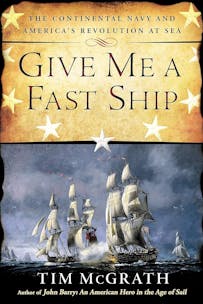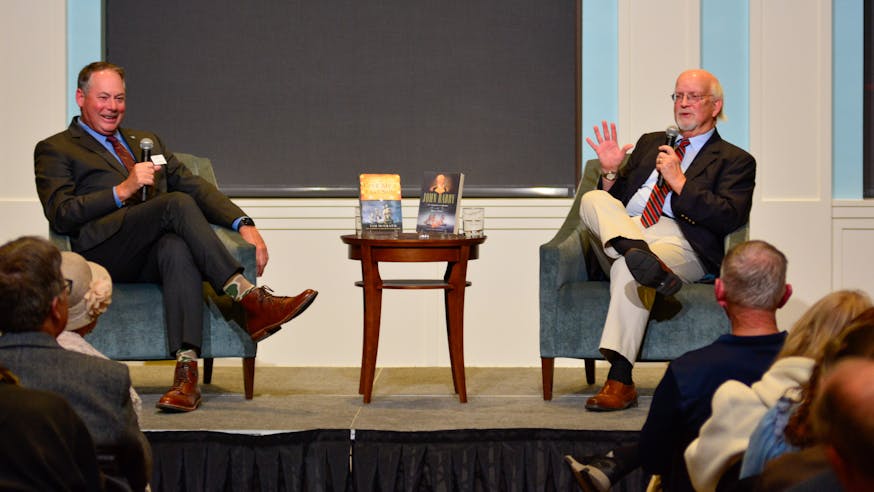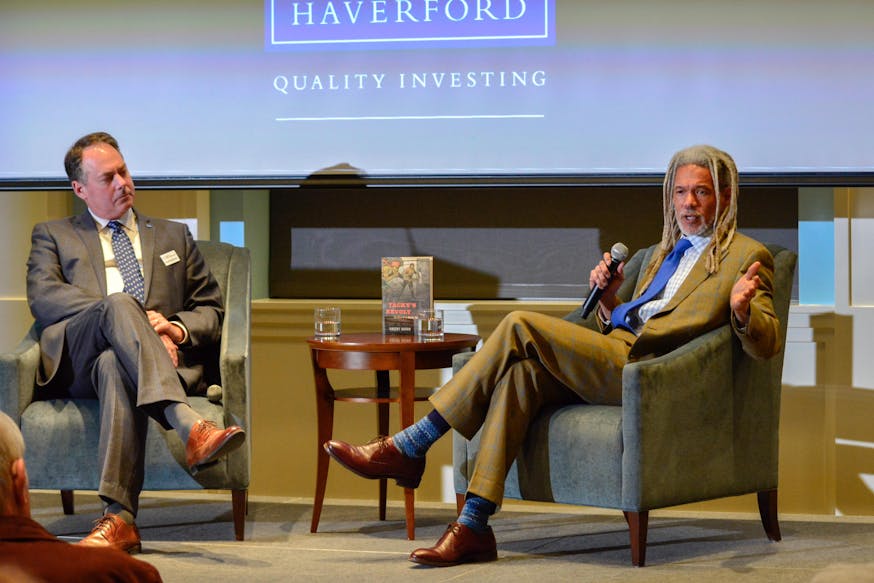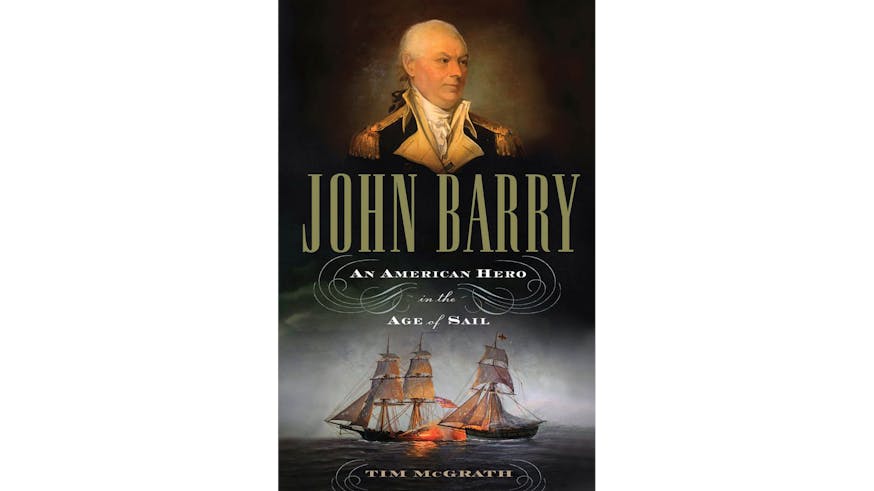Read the Revolution
Give Me a Fast Ship
November 8, 2023
Purchase the book from Penguin Random House.
On the brink of a revolution, Samuel Adams pushed for the creation of an American naval fleet in 1775. Congress did not take Adams’s proposal seriously. Many members of Congress believed that diverting men and money from the Continental Army was futile and dangerous. How could America ever compete with the fighting prowess of the British Navy? How would they recruit enough men when recruitment for the Continental Army was already challenging? Despite reservations from his fellow congressmen, Adams persevered and Congress began buying ships and encouraging men to join the fight as sailors in the fledgling Continental Navy.
Tim McGrath’s Give Me a Fast Ship: The Continental Navy and America’s Revolution at Sea, traces the history of the American Navy from its earliest days to its critical assistance in winning the Revolutionary War. McGrath details the challenges of little funding, shortages in sailors, and the constant capture and destruction of American ships. Using the stories of former merchant captains, like John Paul Jones and John Barry, and their brave crews, McGrath paints a picture of determination and perseverance. The success of the naval fleet during the American Revolution led to the creation of the United States Navy that we know today.
Read an excerpt about Captain John Barry’s May 27, 1781, fight with two British ships, the Atalanta and Trepassey. Injured by a round of grapeshot, Barry and his crew narrowly beat the British ships.
Excerpt
“Ship ahoy! What ship is that?”
Since his days as a young merchant captain, John Barry had asked those questions through his speaking trumpet. This time he was well aware that this vessel and her consort were British and spoiling for a fight. But he always observed the traditions of hailing a ship during peace or war. According to Captain Sampson Edwards, the two ships were “two cable lengths away;” Barry guessed them to be “within pistol Shott.”
“Atalanta, Sloop of War, belonging to His Britannic Majesty,” Edwards replied.
Barry watched as the other ship, the brig Trepassey, inched closer as well. The wind dying by the minute; any sailor could see the spreading stillness across the ocean, now resembling a mirror—and still as glass.
“This is the Continental Frigate Alliance, John Barry. I advise you to haul down your colours,” he said.
“I thank you, Sir,” Edwards continued, hoping to pin Barry down to a conversation until the Trepassey was in position. “Perhaps I may, after a trial.”
The brig was still drifting forward when the wind completely died. Sails were hanging limply against the masts when Barry put an end to this chatter. Nodding to is gun crews, he roared, “Fire!”
The Alliance’s starboard guns belched fire and smoke. Barry’s gunners had honed their skills over this voyage, and the Atalanta’s port bulwark and hull were rocked and ripped by American round shot. Lieutenant Samuel Arden was standing next to Edwards when a cannonball took off his right arm. Edwards immediately sent him below, where the intrepid Arden had his stump cauterized so he could return to the fighting.
Turning quickly to his helmsman, Barry yelled, “Wear Ship!” but there was no wind to turn through. Casting an eye at the Atalanta, Barry saw that Edwards was waiting for the Trepassey to come up. He also noticed a different activity aboard both enemy ships. British sailors had gone below. Soon long oars protruded from both vessels. The men had manned the sweeps. Barry could see what was coming: both ships would row into positions off the Alliance’s stern, where his guns could not hit them. No wonder Edwards had been so unafraid. Barry could only watch as the Trepassey rowed quickly towards the fight, Captain Smyth running out his guns at the same time.
Sign Up
Get biweekly Read the Revolution featured excerpts right to your inbox.
But Smyth’s men were pulling too hard on their oars. With no wind to turn into and slow herself, the Trepassey shot past the Alliance. As she glided by, Barry fired two broadsides into her. Iron and wooden splinters ripped into the rigging and hull, and several of her men fell dead, including Smyth. The second-in-command, Lieutenant King, took Smyth’s lace on the quarterdeck, ordering the men at the sweeps to row the brig out of Alliance’s range before taking position off the frigate’s stern.
In a moment of pure courage, Edwards sent the Atalanta rowing in between the Trepassey and Alliance to give King enough time to escape Barry’s guns. Another well-aimed rebel broadside slammed into the Atalanta, shuddering her masts and tearing her rigging.
Within minutes, both British ships were on the Alliance’s stern quarters. Now the tide of battle turned swiftly and brutally, as fifteen British cannons fired at will into the American frigate in perfect crossfire. If Barry tried to lower boats to row the Alliance out of range, they would be blown out of the water. All he could do was what Jones did at Flamborough Head; he ordered his gunner, Benjamin Pierce, to disconnect a couple of 9-pounders from their ringbolts and set them where they could fire at the enemy, but where their recoil could be minimized.
By now the fighting was an hour old. The three ships were literally yards away from one another, but without a wind the acrid smoke grew so thick that the men could hardly see their shipmates, let alone the enemy. Gunners aimed at the flash of enemy cannon. As he had aboard the Bonhomme Richard, Mathew Parke directed his green-coated marines in the Alliance’s fighting tops to pour fire into both enemy ships. They leveled their muskets towards the British masts that poked through the curtain of smoke, while their comrades fired their coehorns and lobbed grenades at the enemy.
But the battle grew even more one-sided. British gunners switched to grapeshot and reduced their charges, slowing the speed of their projectiles so their shot tore longer splinters out of the Alliance’s bulwarks. Years later, Kessler recalled, “We could not bring one-half our guns nay oft times only guns out astern to bear on them.” He fell with a leg wound. Barry’s clerk, Fitch Pool, was struck by a splinter and taken below. Marine Lieutenant Samuel Pritchard was struck full force by a six-pound ball. Marine Sergeant David Brewer, son of one of Washington’s colonels, was shot through the head; mutineer George Green was impaled on a long, jagged splinter.
By three o’clock the smoke from the battle hung over the three ships like a deadly man-made shroud, while the still Atlantic mirrored every flash of cannon and musket fire. The heavy, humid air smelled of blood and gunpowder; every man on deck, from captain to powder boy, was soaked in his own sweat, many stained with soot and gore. Barry never left the quarterdeck, exhorting his men to keep fighting, passing along any encouragement, seemingly oblivious to the danger all around him. Each British broadside took more of his men out of the fight, but what of it? He was not about to quit.
Below deck, Samuel Kendall and Loblolly Boys were doing their best with the increasing numbers of wounded brought to them. Those who were lightly wounded were quickly patched up and sent back to the fighting; those too mangled by iron and wood were attended with the clinical but quick efficiency so long practiced in war. Sand was continually thrown on the deck to keep Kendall and his assistants from slipping in blood; if he ran out of his supply of laudanum, he doled out rum to dull the pain.
Kendall had just finished with one poor soul when word came from above deck: the captain was being carried below.
Barry was directing the fight from the quarterdeck when he was struck in the left shoulder by a single grapeshot, knocking him prostrate. Momentarily stunned, he rose slowly to his feet, trying to clear his head just as the pain from the wound hit him. Hacker and Parke rushed to his side, but he waved his hand dismissively at them—he refused to go below, although his shoulder was bleeding profusely.
Strong and determined as Barry was, it was at most a few minutes before the loss of blood made him light-headed. His voice lost power, and he became unsteady. Once more his officers begged him to see the surgeon. This time he relented. Hacker called for Kessler and several other hands to bear their captain below.
Kendall was ready for Barry when he arrived. He removed the captain’s coat and cut away his shirt, checking to see how much of it had gone into the body with the grapeshot. He ordered Kessler and the others to remain—holding Barry down, for what came next would be impossible for mere boys. After administering a dose of laudanum or a pannikin or rum, Kendall began his examination.
The ball, about an inch and a half in diameter, was made of iron, not lead like a musket ball, so it did not deform, thereby minimizing any soft-tissue damage. Kendall had a probe among his instruments, but probably used his fingers instead. With the sounds of battle coming from above, Kendall proceeded with his grisly work.
Once he located the ball, Kendall inserted his retractors, widening the wound. Barry’s sailors pressed down hard as he involuntarily writhed in pain. Removing the retractor, Kendall reached for his bullet forceps—a scissors-like instrument with cupped ends shaped for just this procedure. Once the forceps widened around the ball, Kendall closed them. With methodical slowness, he removed them from inside Barry’s shoulder. If the brachial artery had been hit, Kendall tied it off or cauterized it; if there were any bone fragments, he removed them along with any bits of Barry’s shirt and expelled any grumous blood from the wound.
After letting the wound bleed a bit, Kendall cleaned it, putting Barry, still flat on his back, in more agony (patients frequently lost consciousness or went into shock by this point). Kendall dressed the wound with lint dipped in oil.
During Barry’s surgery, Hoysted Hacker assumed command. He had just taken Barry’s place on the quarterdeck when another broadside rocked the Alliance, the grapeshot missing him but instantly killing Quartermaster William Powell at the ship’s wheel. Hacker ordered the gun crews manning the available 9-pounders to return fire when another broadside slammed into their frigate, carrying away the flag. Thinking the Alliance had surrendered, Edward’s sailors manned their shrouds and gave three hoarse cheers.
They were wrong. In second, two American officers stepped over Powell’s body. One took his place at the wheel, while the other seized the fallen ensign and hoisted it by the mizzen brail, near the very spot where Barry had the mutineers hung up and flogged. Second later, the Alliance returned fire, and the battle resumed.
At this point Hacker wavered. There was no doubt he possessed courage, but he had eyes: the battle was being lost by the minute. From the quarterdeck he saw splintered bulwarks, perforated sails hanging limply, shredded rigging, and two deadly rows of guns, of no use at all. Blood, debris, and corpses were everywhere.
If there was a Jonah among the navy’s captains, it was Hacker: he had lost the Columbus at Narragansett, the Providence at Penobscot, and the General Lincoln at Charleston, not from dereliction of duty but by seemingly forever being in the wrong place at the wrong time. After speaking with Parke, Hezekiah Welch, and the other officers, Hacker went below to tell his captain it was time to surrender, an act of courage in itself.
He found Barry sitting up, with Kendall applying a bandage to his shoulder. The captain gave Hacker a dark look before asking what he was doing below. Taking a deep breath, Hacker updated Barry on “the shattered state of sails and rigging, the number of killed and wounded, and the disadvantages under which they labored, for the want of wind.” Then Hacker asked, “if the colours should be struck.”
Fueled by his agony, Barry’s response was deafening. “No!” he roared. Then, to make sure Hacker fully understood his position on the subject, he angrily added, “If the ship cannot be fought without me, I will be carried on deck.” As Barry simultaneously argued with Kendall while bellowing for his coat, Hacker rapidly returned to the quarterdeck, his question answered.
Where another man might have been angry or hurt by Barry’s response, Hacker did not give it any though—there was still a battle going on, and to be won, now at all costs. Kessler saw renewed resolve in Hacker’s face as he “Made known to the crew the determination of their great commander.” When he finished telling the crew they were not about to surrender, “one and all resolved to stick by him.”
Call it fate, call it luck, but just as Hacker revitalized the Alliance’s fighting spirit, each man felt the wisp of a west wind on his sweaty face. Softly at first, it pulled the heavy haze of smoke apart. Kessler and the others inhaled their first clear breath in hours. As each man exhaled, he saw puffs of wind shake, then fill their shot-up sails. Immediately, Hacker ordered some of the men to man the braces, and ordered, “Hard a port.” The battered Alliance answered her helm.
The same soft breeze touched English cheeks, but its arrival meant something different aboard the Atalanta and the Trepassey. Edwards and King sent men back to the sweeps while their shipmates manned the braces, hoping to escape what the Americans had in store for them.
After unleashing one broadside at the Atalanta—the Americans’ first cannonade in three hours—Hacker swung the Alliance around to attack the Trepassey. When there was no wind, the closeness of the British ships to the Alliance was an acute advantage for them; not it became a death trap. Sixteen guns fired in unison at the Trepassey.
Barry was still “in a fit of Irish temper” about rejoining the battle when he felt his ship gently rock and begin to sail. Kendall, having given up arguing, was helping Barry dress when they heard—and felt—the roar of the first broadside against the Trepassey. Seconds later, King lowered his colors.
Sampson Edwards, however, was not yet ready to give up. First and foremost, he had to get the Atalanta away from the Alliance. The rebel frigate came around the Trepassey’s stern and was making straight for the Atalanta, now trying to break off the engagement and escape. But the earlier damage to her masts came into play. The wind was growing stronger as the Alliance rushed up on the Atalanta’s starboard side, her 12-pounders run out, her gunners blowing on their fuses. Suddenly Edwards and his mean heard one sharp crack, then another, as the battered fore and mizzen masts came crashing down, just as Hacker ordered the Alliance’s gunners to fire on the uproll. Edwards struck his colors and called for quarter.
Barry was being helped up the hatchway when there came a sudden silence after this last broadside. It was soon followed by raspy, joyous cheers from the Alliance. Now came their turn to leap into their shrouds, standing—exhausted, but standing—along the port rail. Hearing this, Barry ordered the men helping him to change course and make for his cabin.
Tim McGrath, Give Me a Fast Ship: The Continental Navy and America’s Revolution at Sea (Penguin Random House, 2014), 364-370.
Tags
Learn More

Read the Revolution with Tim McGrath

Read the Revolution Speaker Series

